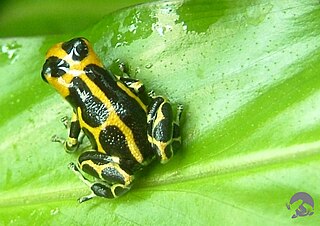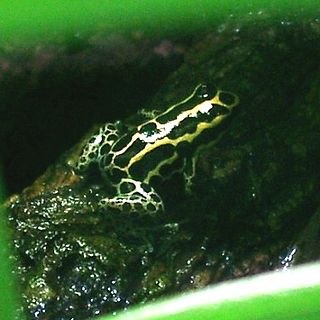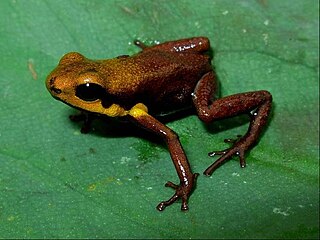
Ranitomeya imitator, is a species of poison dart frog found in the north-central region of eastern Peru. Its common names include mimic poison frog and poison arrow frog, and it is one of the best known dart frogs. It was discovered in the late 1980s by Rainer Schulte who later split it up into more subspecies; describing each as a specific color morph, and sometimes having a separate behavioral pattern. The acoustics, morphs, and behavior of the species have been extensively researched.

The Cauca poison frog is a species of frog in the family Dendrobatidae. It is endemic to Colombia.
Ranitomeya flavovittata is a species of frog in the family Dendrobatidae. It is endemic to Peru and known with certainty only from the Loreto Region where its type locality is.

The blue-bellied poison frog or bluebelly poison frog is a species of frog in the family Dendrobatidae.

The Andean poison frog is a species of frog in the family Dendrobatidae. It is endemic to Colombia.

Ranitomeya vanzolinii, also known as the Brazilian poison frog or spotted poison frog, is a species of frog in the Ranitomeya genus, from the poison dart frog family, Dendrobatidae. It is found in the Amazonian rainforests of Brazil and Perú, and possibly Bolivia.

Andinobates virolinensis is a species of frog in the family Dendrobatidae. It is endemic to Colombia where it is confined to the Santander and Cundinamarca departments on the Cordillera Oriental.

Ranitomeya is a genus of dart poison frogs found in Panama and South America south to Peru and Brazil, possibly into Bolivia.

Ranitomeya amazonica is a poison dart frog in the genus Ranitomeya. It was first described by Rainer Schulte in 1999 as Dendrobates amazonicus when he separated it from Dendrobates ventrimaculatus, primarily on the basis of call characteristics. The validity of the species has been debated, but further studies, also including genetic data, support its validity.

Andinobates is a genus of poison dart frogs from Ecuador, Colombia and Panama. It contains species formerly classified in the genus Dendrobates and in 2006 transferred to the genus Ranitomeya. In 2011 Twomey, Brown, and their colleagues erected the genus Andinobates for a group of 12 species of Ranitomeya. Andinobates frogs can be distinguished from their sister taxon Ranitomeya anatomically in that their 2nd and 3rd vertebrae are fused. They show no limb reticulation, which is present in most species of Ranitomeya.

Ranitomeya summersi, sometimes referred to as Summers' poison frog, is a species of poison dart frogs found in the central Huallaga River drainage and adjacent Cordillera Azul National Park in central Peru. Before 2008, the species was considered a subspecies of Ranitomeya fantastica. The IUCN considers it an endangered species because of limited habitat range, habitat loss, and collection for the pet trade.

Ranitomeya benedicta, sometimes called the blessed poison frog, is a species of poison dart frogs found in the lowland rainforest of the Pampas del Sacramento in southern Loreto and eastern San Martín Region, northeastern Peru. Before 2008, the species was considered a subspecies of Ranitomeya fantastica. The IUCN considers the species vulnerable because of limited habitat range, habitat loss, and collection for the pet trade.

Andinobates dorisswansonae, the dotted poison frog, is a species of amphibian in the family Dendrobatidae, endemic to Colombia in the outskirts of Falan and north of the department of Tolima. It is toxic to humans.

Andinobates tolimensis, the Tolimense poison frog, is a species of amphibian in the family Dendrobatidae, endemic to Colombia in the outskirts of Falan and north of the department of Tolima. Previously it was included in the genus Ranitomeya, but was reclassified in Andinobates, along with 11 other species. It is threatened by habitat loss. It is toxic to humans and when captured will excrete a milky substance.

Ranitomeya uakarii, known as the red uakari poison frog, is a species of frog in the family Dendrobatidae. The species can be found in the Amazon basin, specifically in Brazil and Peru.
Ranitomeya cyanovittata is a species of frog in the family Dendrobatidae. It is native to Peru and scientists expect it also lives in Brazil.

Ranitomeya yavaricola is a species of frog in the family Dendrobatidae. It is endemic to Peru and possibly nearby Brazil.
Ranitomeya toraro, the Apuriná poison frog, is a species of frog in the family Dendrobatidae. It is endemic to Colombia and Brazil and possibly nearby Peru.
Andinobates daleswansoni is a species of frog in the family Dendrobatidae. It is endemic to Colombia.
Hyloxalus sordidatus is a species of frog in the family Dendrobatidae. It is endemic to Peru.














